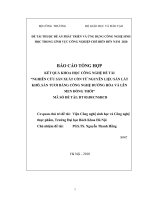Sản xuất biodiesel từ nguyên liệu vi tảo Spirulina sử dụng trực tiếp gần điều kiện metanol siêu tới hạn
Bạn đang xem bản rút gọn của tài liệu. Xem và tải ngay bản đầy đủ của tài liệu tại đây (502.49 KB, 16 trang )
Biodiesel Production from Spirulina Microalgae Feedstock
Using Direct Transesterif ication Near Supercritical Methanol
Condition
Reporter: Tran Thanh Phuc
Lecturer: Do Quy Diem, PhD
Outline
•
•
•
•
Introduction
Materials and methods
Results and discussion
Conclusions
INTRODUCTION
BIODIESEL
INTRODUCTION
INTRODUCTION
Spirulina Microalgae
Alcohol in the presence of an alkaline catalyst
•
High productivity of lipid
•
Non-eatable source
•
High growth rate
•
Growth in water (freshwater or seawater)
•
Environmental benefits of diminishing CO2 from air
•
Bioremediation of wastewater from pollutants
BIODIESEL
INTRODUCTION
Drawbacks
direct transesterification
Lipid extraction from biomass is difficult
Drawbacks
Separation of used catalyst from products and treatment of wastewater
Supercritical in-situ transesterification
•
•
Simple and has the advantages regarding environmentally-friendly properties, high conversion within a short time,
No need for using acid or base catalysts and so consequently, no need for post treatment
INTRODUCTION
Supercritical
Any substance at a temperature and pressure above its critical point
Distinct liquid and gas phases do not exist
Critical point
•
•
It can effuse through solids like a gas, and dissolvematerials like a liquid.
The molecules in the supercritical fluid have high kinetic energy like a gas and
high density like a liquid.
MATERIALS AND METHODS
MATERIALS AND METHODS
The reactor was heated with an electric heating jacket while the temperature was sensed using a
thermocouple
Pressure was fixed at equilibrium pressure of 12MPa in all the experiments
The impact of biomass was neglected
Interaction parameters in SRK EOS between methanol and n-Hexane, methanol and water, and nHexane and water was obtained 0, -0.9 and 0.51090, using Aspen-Hysys software databank
Temperature and pressure of n-Hexane is lower than methanol
Tubular batch reactor
Tecrease the critical temperature and pressure of the system
MATERIALS AND METHODS
The reactor was brought out of the heating jacket and was immersed into an
ice water
FAMEs and n-Hexan
Filtered
Methanol, glycerol and other polar
Segregated and retained
compounds
Washed
FAMEs are transferred to n-Hexane phase
Transferred to separatory funnel
GC-MS
BIODIESEL
RESULTS AND DISCUSSION
Experimental conditions and alkyl esters yields
Methanol- to-dry
Co- solvent- to-dry
algae
algae
40
6
275
20
3
250
4
Run order
Temperature
Time
1
275
2
Critical Pressure
Moisture content
Critical Temperature (oC)
6
20
240.89
5.50
29.92
10
2
60
248.54
7.77
24.89
30
8
0
40
249.14
8.78
11.32
225
40
10
2
60
248.54
7.77
3.68
5
225
40
10
6
20
240.58
6.09
8.46
6
300
30
8
4
40
244.88
6.61
99.32
7
275
40
10
2
20
242.35
7.31
73.49
8
250
30
4
4
40
247.48
5.97
11.33
9
275
40
6
2
60
252.56
7.63
95.75
(Mpa)
FAME yield (%)
RESULTS AND DISCUSSION
Methanol-to-dry microalgae ratio effect
RESULTS AND DISCUSSION
Hexane-to-dry microalgae ratio effect
The presence of additional n-hexane as a co-solvent had a negative impact on the
efficiency of biodiesel production
In supercritical condition, methanol plays as solvent in addition to its
reactant role
No need for another solvent and the additional solvent just reduces
the concentration and density of the reactants
RESULTS AND DISCUSSION
Moisture content effect
(2) Water can form a hydrated layer around
(1) Fatty acid methyl ester production reaction is a
the biomass and prevent the lipid from bulk
reversible reaction and water can reverse the
releasing into the reaction medium
esterification reaction toward methanol and free fatty
(3) Triglyceride hydrolysis reaction may
acid production
occur instead of transesterification
reaction
Increasing percentage of humidity fatty acid
methyl ester yield decreased
CONCLUSIONS
Maximum yield of 99.32% in comparison with the reference method
Study various aspects of biodiesel production, by the method described, in order to reduce operating costs and industrialize
this procedure can be considered as future work









